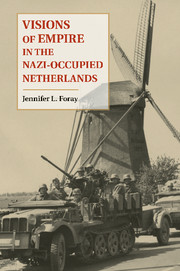Book contents
- Frontmatter
- Contents
- Acknowledgments
- Abbreviations
- Introduction
- 1 War Comes to the Kingdom
- 2 The Landscape of Resistance and the Clandestine Press
- 3 “Look to the East!”
- 4 “Indies Lost, Disaster Born”
- 5 Mutuality, Equality, and the Commonwealth
- 6 Countering the Commonwealth
- 7 “After Our Liberation, That of Indonesia”
- 8 Wartime Consensus and Postwar Pressures
- Conclusion
- Bibliography
- Index
- References
8 - Wartime Consensus and Postwar Pressures
Published online by Cambridge University Press: 05 December 2011
- Frontmatter
- Contents
- Acknowledgments
- Abbreviations
- Introduction
- 1 War Comes to the Kingdom
- 2 The Landscape of Resistance and the Clandestine Press
- 3 “Look to the East!”
- 4 “Indies Lost, Disaster Born”
- 5 Mutuality, Equality, and the Commonwealth
- 6 Countering the Commonwealth
- 7 “After Our Liberation, That of Indonesia”
- 8 Wartime Consensus and Postwar Pressures
- Conclusion
- Bibliography
- Index
- References
Summary
While those living in the northern half of the Netherlands suffered though one final and especially brutal winter under German occupation, the queen and her ministers in London planned their return. In early September 1944, the government-in-exile decreed that areas liberated by the Allies in the southern part of the country would be brought under the jurisdiction of the new Dutch Military Authority (Militair Gezag or NMA/MG). As conceptualized in London, this Military Authority would serve as the liaison between the Dutch government-in-exile and local Allied commanders, and at the same time would constitute an interim military administration until the government-in-exile was able to return. Hoping to reestablish Dutch rule as quickly as possible, Anglo-American forces granted this Dutch Military Authority great room to maneuver on the condition that its work not interfere with Allied military objectives. All did not proceed according to plan, however. Within months, the queen, her ministers, the Dutch Military Authority, and former resisters in the liberated southern parts of the country all found themselves jockeying for political control. Particularly contentious were the purge actions directed against politicians, business leaders, journalists, and other individuals accused of collaborating with the German occupiers. On the whole, resisters in liberated areas sought further involvement in these purges because they considered them too lenient and haphazard. In these and other matters, the queen tended to align herself with the “heroes of the resistance.” This position brought her into direct conflict with members of her cabinet, established political figures who admired the resistance movements but did not necessarily support the far-reaching political, social, and economic policies some of them had proposed.
Given such tensions between the liberated areas and London on the one hand and the queen and her ministers on the other, the fall of the government-in-exile in late February 1945 came as little surprise. The new government of February 23 – Prime Minister Pieter Gerbrandy’s second wartime government – adopted a more hard-line position toward these purges, a stance that bridged some of the divide between London officials and former resisters in the liberated regions. Gerbrandy’s new government also signaled the departure of Minister of Colonies Hubertus van Mook. Appointed Lieutenant Governor General and Acting Governor General for the East Indies a few months prior, van Mook wished to avoid the clear conflict of interest presented by his simultaneous service in both the East Indies and the cabinet. With van Mook’s departure, the Ministry of Colonies itself also came to an end. Van Mook’s successor, professor J. I. J. M. Schmutzer, now assumed the title “Minister of Overseas Territories,” a slight change in nomenclature nonetheless signaling a government willing to consider at least token colonial reform. One month after the Dutch government-in-exile instituted this name change, the French followed suit, perhaps because, as Martin Shipway argues, the French sought to “match or surpass the British and Dutch declarations concerning the future of their empires.” As of March 1945, the French “Ministère des Colonies” became the “Ministère des Territoires d’Outre-mer.” Even with such relatively minor changes, the European empires appeared to be forging a new path, and contemporary observers would have had reason to believe that after the conclusion of wartime hostilities, rhetorical maneuvers would give way to substantial legal, political, and socioeconomic reforms.
- Type
- Chapter
- Information
- Visions of Empire in the Nazi-Occupied Netherlands , pp. 253 - 298Publisher: Cambridge University PressPrint publication year: 2011



